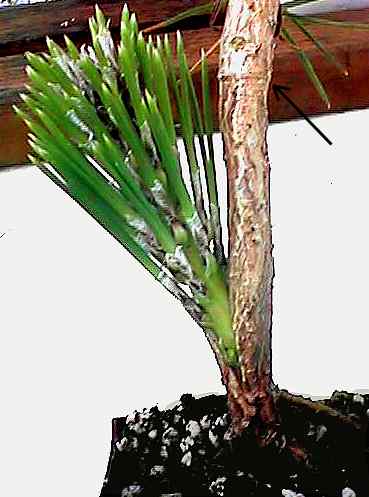
| Articles | Home Page | Images | Order Form | Plant Catalog |
Suckering problems occur in such genera as Liquidambar, Malus (apple), Pyrus (pear), and Prunus ( cherry, plum, apricot), Crataegus (hawthorn), and others deciduous woody plants. Profuse suckering leads to endless pruning and bud rubbing to keep the suckers from overrunning your cultivar. The problem is particularly bad after major pruning, for example, after a trunk chop to get a low curve and taper to the trunk. Sometimes the scion will actually die and the understock will take over the plant after such drastic pruning.
In addition, there is often an unsightly graft union in these plants. The differing bark characteristics can make the union stand out dramatically and detract from the trunk, and the illusion of an ancient rugged tree. Growth rate mismatches can often lead to a 'necked down' appearance for smaller dwarf cultivars on standard rootstocks, exactly the kind of plants we are looking for in bonsai. Even worse is the problem of the scion growing faster, resulting in REVERSE taper. Prunus species often form a burl at the graft union that is prone to insect damage and completely unusable for bonsai purposes.
Most of these species can be grown from cuttings without too much difficulty. Some are extremely difficult, such as cultivars of Crataegus (hawthorn). Crataegus laevigata 'Paul's Scarlet' cuttings will sometimes take three years to root. It is also possible to air layer many of these species to get them on their own roots.
Conifers present the larger challenge. While most Juniperus, Chamaecyparis, and the broad leaf evergreens can be grown from cuttings, it is the pines that pose the greatest problems. Some pines can be grown from cuttings, but it is almost always easier to graft them.
Other than this style, the grafts should always be low. It is very difficult to obtain low grafts. 99% of the pine grafts are made for landscape and not bonsai, so it takes a nursery dedicated to bonsai or one which is sensitive to the needs of bonsai enthusiasts to produce good bonsai grafts. A few large nurseries that produce the bulk of grafted pines in this country have been persuaded to produce some grafts for bonsai, so things are beginning to change.
The very best grafts are 'root grafts'. The scion is not actually grafted to the roots, but rather to the stem tissue below the 'crown' that forms when the seed emerges from the shell. This is a small ring of tissue on the stem that clearly marks the division of root type tissue (was the radicle of the seed) and the true stem which is capable of producing foliage. On pines and cedars this 'root' portion of the stem can be very long, as much as six inches or more before actual roots appear.
For bonsai the seedling understock is potted up high so that the root portion of the stem stands several inches above the pot. This makes is easy to do a low graft. The graft can be placed just below the crown ring and after the graft takes, about a year later, the whole thing buried so that the graft sits right at the soil line. Since the buried stem portion is root tissue it can stand this procedure and has the possibility of forming roots. Grafted in this fashion the union will blend perfectly into the nebari (crown and surface roots). Also, since there is usually a bulge for dwarf cultivars, what was once a liability now becomes an asset since the swelling will be right at the crown.
If your graft is below this ring of tissue, you may bury it up to the graft. If it is above the crown ring you can still bury it, but you must be much more careful. It is akin to air layering. Bury the stem section in sand after making some vertical slices in the stem where you want roots and treating with hormone. This will work for all pines that are 'low grafted', that is have a graft only an inch or so above the crown ring. If the pine is 'high grafted' it will have to be air layered.
I recently went to a local bonsai nursery and checked out the potted up White pines and the grafts were hideous. Very nice little styled trees, a dwarf cultivar, grafted onto white pine with the understock about twice the diameter of the scion with no effort to conceal the graft.
This procedure also applies to Japanese Black Pine cultivars, Pinus thunbergii, as well, and is especially important for the rough bark ones. There is nothing more ludicrous than a nicely styled Nishiki Kuromatsu with two inch bark wings floating above a relatively smooth lower understock section. To get really picky, the very best rough or cork bark black pines will be grown from cuttings so even the surface roots will show the corking. I have a rough bark Japanese Maple, Acer palmatum 'Arakawa' that has such corked surface roots (cutting grown). It is quite amazing.
A little more information on identifying the crown ring. Look low on the stem, or uncover the stem by removing some soil and look for a point where the bark changes texture. For pines and cedars the root portion usually is smooth except for little bumps. Above the ring, which is usually a slight swelling, the bark is usually ring like. Try looking at cedars first, since it is unmistakable on them, and then on a pine. This feature usually disappears after a few years as the root portion attains mature bark if it is above ground.
copyright 1996, all rights reserved